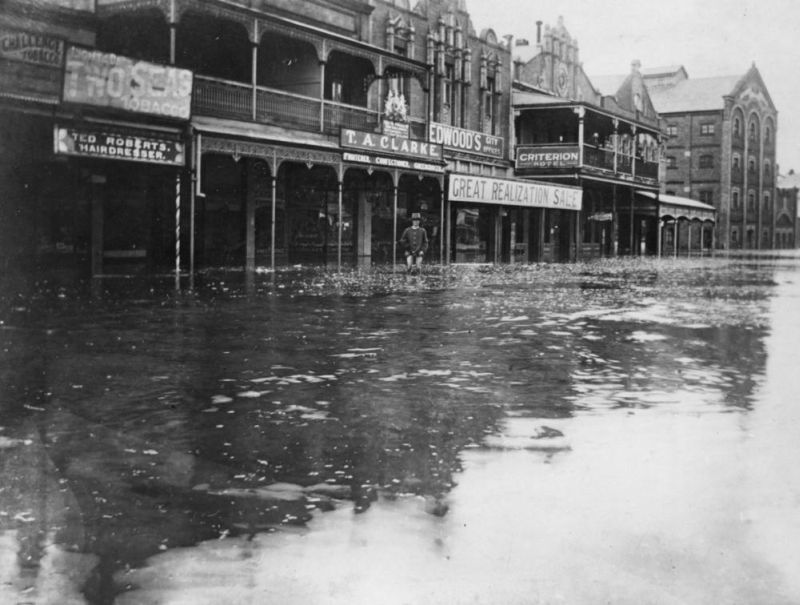Queensland floods: information, history and knowledge
The coincidence of the Queensland Floods Commission of Inquiry and Information Awareness Month offers the opportunity to explore how well our communities are using information and knowledge in regard to natural disasters. The purpose of Information Awareness Month is to increase public awareness of information and its place in all aspects of daily life.
In early January this year the media carried horrific images and stories of the loss of life and damage caused by flooding in the southern Queensland towns of Toowoomba and Grantham and in the cities of Brisbane and Ipswich. Surprise was expressed at how such severe events could have happened. But the reality is that these floods have their predecessors.
The National Library of Australia Trove is a new information discovery experience focused on Australia and Australians. It supplements what search engines provide. A Trove search reveals Toowoomba has previously suffered devastating floods, including three floods within a 22-year period in 1893, 1906 and 1915. The historical newspaper articles reporting these floods make for harrowing reading. For example, in 1915, “In one of these Russell street shops there were two women, and the force of the water eventually caused the back portion of the building to collapse. The women, terror-stricken, rushed into the flooded street. A man from the National Hotel assisted them to a cab, which a plucky driver drove into the swirling waters. In another case a man endeavoured to cross the flood when it was at its highest. He succeeded in getting halt way through, when he was overcome, and was dragged out in a half drowned condition.” An image from the 1906 flood shows the flood level in the Toowoomba city centre.

Historical newspaper articles accessed through Trove similarly reveal severe past flooding in Grantham, for example in 1893, 1931 and 1951. The 1893 article states that “the flood waters at Grantham were over the telegraph wires” which indicates a significant volume of floodwater, but it’s not clear from the articles if any of these floods involved a tsunami-like flash flood as occurred in January 2011. The Grantham flood articles also describe severe flooding elsewhere in south-east Queensland, as do further articles accessed through Trove, for example articles describing floods in the Nerang River area in 1929, 1933 and 1947.
The Bureau of Meteorology has chronicled the history of the known floods in the Brisbane and Bremer Basin of south-east Queensland since 1824. In this relatively short period of recorded history there have been a large number of floods, several of them major. The highest flood in Brisbane’s recorded history was in January 1841.
Can better use of such historical information overcome faded memories and lead to better knowledge and awareness about contemporary flood risk, and better planning to address that risk? This is explored in the ABC Radio National Rear Vision story Deluges that have gone before: floods in Australian history which puts forward some confronting perspectives about the shortcomings of current approaches. For example, Richard Evans, a historian and writer who specialises in the history of natural disasters in Australia states:
“Reading the reports of various official inquiries which follow any sort of disaster event — cyclones, bushfires, floods — they are eerily similar. They will almost inevitably find very similar contributing factors to the severity of the disaster; they will make very similar recommendations, and they will, sad to say, usually be largely ignored in the longer term. In the short term there will be interesting commitment, but it doesn’t last more than a few years, certainly it doesn’t last decades. What really strikes me is how we have the disaster, we have the inquiry, we find out the same painful bitter lesson that too many of the people who live here don’t understand the nature of the place they’re living in, and then they forget it again. And then in the course of a generation or generation-and-a-half, the disaster recurs, and we have lives lost, property destroyed, inquiry, recriminations, report, recommendations, and then again, we forget.”
Fortunately the situation in regard to knowledge and awareness of Australia’s climate history is starting to change. The landmark South Eastern Australian Recent Climate History (SEARCH) project spans the sciences and the humanities and has drawn together a team of leading climate scientists, water managers and historians to better understand south-eastern Australian climate history over the past 200–500 years. It is the first study of its kind in Australia.
See also Queensland floods: what do history and river hydrology tell us?